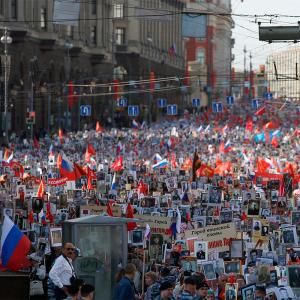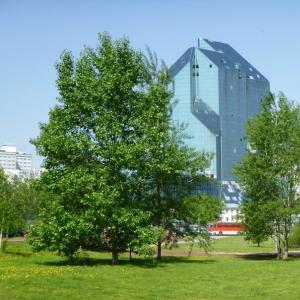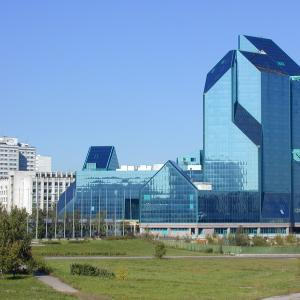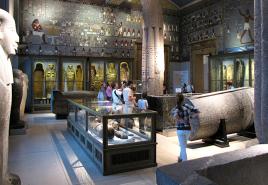"Immortal Regiment": an action that united millions. "Immortal Regiment": an action that brings together millions Work that is carried out all year round
A strong, emotional and endlessly touching procession of the "Immortal Regiment" annually unites millions of people around the world. How it goes in Moscow - we tell.
Folk roots
At first glance, it may seem that the movement of the "Immortal Regiment" is a young phenomenon. This is partly true, but it is important to understand that in one form or another such actions took place long before today. So, it is known that back in 1965, students of the 121st school came out onto the streets of Novosibirsk with portraits of veterans. In 1981, residents of the village of Tatsinskaya, which was then celebrating its centenary, marched with photographs of their dead sons, according to director Yulia Sinelnikova, who organized the holiday. Moreover, such parades were held not only in the USSR and Russia - in 1999, for example, a mournful and memorable event took place on the streets of Jerusalem.
Residents of the village of Tatsinskaya in 1981. Photo: from the archive of Yulia Sinelnikova
Dozens of similar actions were spontaneously invented by the most ordinary people - everyone whose families were affected by the hardships of the war years. People came out with portraits of their deceased relatives, because their heart and that very historical memory that defied logical explanation told them so. In this sense, the "Immortal Regiment" has become only a synergy of local events, the formulation of a general popular idea, a movement in which everyone could participate.
In Moscow, the action was first held in 2013 - then the march gathered about a thousand people. However, two years later, on the day of the 70th anniversary of Victory, half a million people took to the streets of the capital. And a couple of months later, a separate all-Russian public civil-patriotic movement "Immortal Regiment of Russia" emerged, which to this day is engaged in preserving the people's memory of the terrible years of the Great Patriotic War.
 Action "Immortal Regiment" in 2015 in Moscow. Photo: AGN "Moscow"
Action "Immortal Regiment" in 2015 in Moscow. Photo: AGN "Moscow"
A meaning that cannot be imposed
The main thing that distinguishes the "Immortal Regiment" from other civil movements is its absolute nationality. All generations, all nationalities and all views converge here - after all, one way or another, the Great Patriotic War did not bypass anyone.
However, there is another secret. The thing is that the "Immortal Regiment" is not only about a common tragedy, but also about a personal, family one. Every year people take to the city streets with portraits of their relatives - those whose memory cannot be betrayed. It is she - personal memory - that is the main meaning of the "Immortal Regiment". The most real, not invented and therefore so valuable.
 During the Immortal Regiment action in 2018 in Moscow. Photo: Alexander Avilov / AGN "Moscow"
During the Immortal Regiment action in 2018 in Moscow. Photo: Alexander Avilov / AGN "Moscow"
For people, the "Immortal Regiment" became a sincere occasion to study family archives, revive the history of generations and pass it on to their children, remember their roots and, what is important, digitize these memories. The production of each banner becomes a special experience of familiarization for everyone, and participation in the procession is a reason for pride, first of all, for your family.
According to the rules of the action, only their immediate relatives can carry photographs of participants in the war. If you do not have any information about a veteran ancestor, you can honor the memory of those who did not manage to start a family, or who have no living relatives - information about these war heroes is stored in military commissariats and veterans' councils.
Memory path
Today, the "Immortal Regiment" is more than 1000 participating cities around the world (in 2016, for example, the procession took place in more than 60 countries). In Moscow, the action takes place annually along an impressive route through the city center and to Red Square. The road is divided into several sectors.

This year, the procession starts at 15:00, the gathering of participants is scheduled for 14:00.
It is not necessary to start the journey from the very beginning (that is, from the Dynamo metro station): you can join the column, for example, from the Belorusskaya, Mayakovskaya, Pushkinskaya, Chekhovskaya and Tverskaya stations. Important: the last three stations will close at 13:00, and "Mayakovskaya" - as the street fills, so it is better to approach the selected "point" in advance. The movement is directed by volunteers (you will recognize them by a special form), who, of course, can be contacted for all the information.
The route runs along Leningradsky Prospekt, st. Tverskoy, st. Tverskoy-Yamskaya, through Okhotny Ryad and Manezh, and ends on Red Square. Then the procession will be divided: it will be possible to turn onto Moskvoretskaya embankment and go towards the Kitay-Gorod metro station, or head to Tretyakovskaya through the Bolshoi Moskvoretsky bridge. The road is long, so choose comfortable shoes and dress for the weather. The organizers also advise you to take a plastic bottle of water with you (with a "glass" will not be allowed), although this year water will be distributed free of charge. Don't forget your passport just in case.
 "Immortal Regiment" on Red Square in 2017. Photo: Andrey Lyubimov / AGN "Moscow"
"Immortal Regiment" on Red Square in 2017. Photo: Andrey Lyubimov / AGN "Moscow"
A special experience
Victory Day is a sad and at the same time solemn holiday, and therefore be prepared for the fact that during the 7-kilometer route you will experience a whole range of emotions. This year, for example, it will be possible to feel the wartime atmosphere in specially equipped field kitchens, where soldiers' porridge and sweet tea will be served. On the way, the volunteers will also share with the participants souvenir paraphernalia - flags, St. George's ribbons, stickers, caps and balls.
 A volunteer distributes flags during the Immortal Regiment campaign in 2018 in Moscow. Photo: Alexander Avilov / AGN "Moscow"
A volunteer distributes flags during the Immortal Regiment campaign in 2018 in Moscow. Photo: Alexander Avilov / AGN "Moscow"
Of course, there will also be music: 500 musicians are responsible for it as part of concert brigades and amateur art groups. It will also be possible to assess the scale of the column (although the organizers themselves rightly emphasize that the Immortal Regiment is by no means a race “for performance”) in real time: screens with video broadcasts will be installed along the entire route.
 Participants of the action in Moscow in 2018. Photo: Alexander Avilov / AGN "Moscow"
Participants of the action in Moscow in 2018. Photo: Alexander Avilov / AGN "Moscow"
How to participate
The main idea of \u200b\u200bthe procession is nationality, so anyone can take part in it. No registrations and even more so no fees will be required. All you need is to come to the meeting place with a portrait of your relative. There are no strict requirements for the design of the photograph: it is important that it is a photograph (the optimal size is A4), under which the name and surname of the veteran and, if known, his military rank are indicated.
The photo should be placed on a rigid banner - you can digitize the photo and make a layout for free at the MFC branch or in any photo printing salon (some, by the way, also provide the service for free). However, if you choose the second option, be vigilant and do not allow the logo of one or another company to be placed on the banner next to the portrait - such promotions do not tolerate any kind of commerce.
 "Immortal Regiment" in Moscow in 2018. Photo: Alexander Avilov / AGN "Moscow"
"Immortal Regiment" in Moscow in 2018. Photo: Alexander Avilov / AGN "Moscow"
Work that takes place all year round
Over the years of its existence, the "Immortal Regiment" has become not just a march on May 9, but a whole movement recognized to preserve the memory of all the participants in World War II: veterans, partisans, home front workers, blockades, children of war and those who gave their lives in concentration camps. Of course, a march alone is not enough in this case, and therefore work to perpetuate the heroic deeds of the soldiers is ongoing. Here are just a few projects that deserve attention.
Tours
We learn a lot about the hardships and highlights of the war from books, films, history books and in museums, but sometimes we forget about the most obvious source of historical knowledge - our hometown. That is why open excursions to memorable places of the capital will be held in Moscow throughout the week preceding Victory Day.
This year, Muscovites and guests of the city will have seven thematic walks accompanied by experienced guides.
Have you ever thought, for example, about how the relationship between the two star generals of the USSR - Zhukov and Rokossovsky - developed? Were they friends or eternal rivals? Find out the answers in Bella Voronova's author's excursion
 "Immortal regiment" in 2018 in Moscow. Photo: Alexander Avilov / AGN "Moscow"
"Immortal regiment" in 2018 in Moscow. Photo: Alexander Avilov / AGN "Moscow"
What areas of the capital were the first to suffer from fascist bombs, how did the Moscow air defense differ from the London one, where Napoleon fled from the Moscow fire? On May 1 and 4, in a two and a half hour excursion, you will learn what you had to look for in several history books at once.
On May 3 and 5, approach the monument to Ernst Telman on Chernyakhovsky Street (Aeroport metro station) for a fascinating excursion - to find out how domestic aviation developed and what happened to it during the Second World War.
On May 4 and 5, take a look at VDNKh, where an excursion under a romantic name will take place to find out which of the designers and cosmonauts showed themselves at the fronts of the Great Patriotic War and whose calculations the Americans used in the famous Apollo program.
You will learn about how the USSR almost lost its key object - Losinoostrovskaya station - and who saved it from complete destruction, on May 5 and 8 on a tour.
Did you know that the famous Memorial Complex on Poklonnaya Hill was thought back ... in 1942 - before the Battle of Stalingrad and the Kursk Bulge? So strong was the USSR's confidence in the defeat of the Nazis. You will hear about the fate of Victory Park and the symbolism of this place during the excursion.
 View of the building of the Belorussky railway station. Photo: mos.ru
View of the building of the Belorussky railway station. Photo: mos.ru
Finally, on May 7 and 8, there is a chance for two hours to immerse you in the history of the "Moscow window to Europe" - the Tverskaya Zastava square and the one standing on it. The military history of this place is really colorful and rich, because it was from here that soldiers and officers went to the front in 1941 and it was here that the victorious soldiers arrived triumphantly from Berlin in 1945.
All tours are free of charge, but registration is required.
Internet portal polkrf.ru
What if all the heroes of the war were alive and could independently tell the whole world their story? The memory of each is carefully collected by relatives and all those who are not indifferent on the site polkrf.ru, which was created using social networking technologies. Each veteran has his own "profile", which contains all the information found about him - who he was, where he served, what happened to him in the war, or how his life developed after May 9, 1945. The project plans to unite on one platform about 300 million users - relatives of those who fought at the front or worked in the rear.
Exactly at 22 o'clock, the first salute will be thundered. Literally, the brightest moment on May 9 will come. Looking into the evening sky, everyone will think about their own. But there is something that unites this day. With simple and warm thoughts, today almost eight million people throughout Russia took part in the Immortal Regiment march. Two million more than last year. The action became truly nationwide. 850 thousand people came out in Moscow alone. This became important to all of us.
Especially from a bird's eye view you can see how this river of life and memory stretches through the center of Moscow. A real sea of \u200b\u200bpeople. And the day that united, with the thread of Victory, connected all generations - both those who died in battles and the living; and those who had this happiness - kissing their hands and hugging them tightly, thanks for a peaceful life, and those who know their heroes only from stories and letters, from not always clear photographs that are kept at home as the most valuable memory. They took them out today for everyone to see - here he is, my hero!
Between the metro station "Dynamo" and the square of the Belorussky railway station, an hour before the start of the procession, there is a complete feeling of celebration. We are with us now all those who decided to go this whole path - almost six kilometers to Vasilievsky descent and always past the iconic place. After all, here, on the platform of the Belorussky railway station, they said goodbye in 1941, seeing off to the front, and rejoiced, meeting those who survived and gave victory.
The faces, all as one, simple and open. Eyes that know the value of life and such dear happiness - to live without war, without fear and tears. Their gift to us, the current ones, cannot be appreciated by anything. All that we can do is just walk with them in the same formation, squeezing the frames with unclear photographs to white knuckles and guessing similar features in their great-grandchildren and great-great-grandchildren on the go.
Someone has no cards with their heroes left at all. And the time was difficult - no time for photographs. And some of them simply did not survive the terrible years. But it is important that the memory is alive. And many are full of photographs. Families left for the war.
“This is my father, this is his uncle, they survived after the war. And the older brother - he was missing. These are three brothers, all survived. And one lost his memory and lost his family, ”the participants of the procession say.
Looking at the portraits, you clearly understand: from the first day they all believed in Victory, that they would soon return home, but they will never forget their fighting friends. They believed, and therefore did not extinguish in themselves living feelings for the most dear and loved ones, who knew how to wait like no one else.
A striking story took place today almost live. The two sisters, who had never seen each other in 60 years, met during the "Immortal Regiment" - they recognized each other from the same photographs and told the journalist of the First Channel Pavel Krasnov about their father.
“My granddaughter suddenly saw a portrait of our grandfather, my father. We come up, I say: you are probably Lena! A daughter by his first wife. And this is our father. And so we met today ”, - says the participant of the action.
In the column of the "Immortal Regiment" today - and Vladimir Putin with a portrait of his father, Vladimir Spiridonovich Putin. He went to the front in June 1941 and, defending the Nevsky Pyatachok, a key bridgehead during the breakthrough of the Leningrad blockade, was seriously wounded by a grenade fragment. And today there is not a single soldier's fate, and even more so, a heroic deed that would not upset the soul.
How often they tried to find each other after the war. That pain ached, and the front-line friendship was stronger than tank armor, did not give rest. "Where are you now, fellow soldiers?" they whispered all their lives like a prayer. And everywhere it seems to spread today: "We are all here!"
People are cheerful and friendly, sincere and cheerful. But it is impossible to fully describe the sensations from here, from within the procession in simple words. It's pretty chilly today, but the air itself seems to be heated with emotion. Here, on Pushkin Square, we are no longer hundreds, and not even thousands, but tens of thousands - people with portraits flock from all the surrounding lanes. As they say, our regiment arrives, and in front is the heart of the capital.
For the first time in 75 years in the hands of his great-great-grandson, a wooden accordion sang today “Katyusha” to the delight of people.
“Our great-grandfather, he loved her, he never parted with her. Unfortunately, he died. And finally, we are transmitting these sounds, this joy to the rest of the people, ”says the participant of the action.
Much of what keeps the warmth of the hands of the winners, their descendants took with them today.
“This is my grandfather's helmet. He was a tanker until he became a pilot. The war was very noisy, there were explosions, and therefore it was specially made so that at least a little you could not hear them, quietly, ”says a participant in the procession.
Military marches on bagpipes are not at all exotic for pep. Another reminder that this was our common victory over fascism with allied countries, from where dozens of descendants of World War II soldiers also came. Thomas Connolly is a Scottish Guardsman. Smashed the Nazis in France, Belgium and Germany. His son Gordon Connolly says he could not help but come out.
“This war united everyone and showed what a feat Russia accomplished for the whole world. My father told me that we owe you for the fact that now we live in the world - it was you who lost millions of people, more than any other country, ”he says.
“My father fought shoulder to shoulder with Soviet soldiers. Said they were great guys. He liberated Europe, and it is very important for me that today he is at this grand celebration, ”says John Paterson, son of a World War II veteran.
The grandson of Yuri Nikulin, his full namesake, together with his great-grandchildren Stanislav and Sophia, are for the first time in the Immortal Regiment with a portrait of his famous grandfather. Senior Sergeant Nikulin was awarded medals "For Courage" and "For the Defense of Leningrad". It is not easy to recognize another legend of our cinema in this picture - Anatoly Papanov commanded an anti-aircraft artillery platoon at the front, and in 1942 he was seriously wounded.
“For him, of course, Victory Day was the most important holiday of the year. He put on his orders, medals, because he had them. When their platoon occupied a village, and the whole village was burned out, and in the morning they hear that a rooster crows! Dad says: we covered him with an overcoat, gave him some water, fed him something, and they had this rooster as a symbol of a peaceful life, ”says Elena Papanova, the daughter of Anatoly Papanov.
“Zoya Kosmodemyanskaya, my grandfather’s sister, and already today people are approaching and asking. This is the same Zoya, who was in the partisan detachment, who was the first woman hero of the Soviet Union. This is my duty, and it is very important for me that her feat is not forgotten. And so that people remember those who fought for them in the Great Patriotic War, ”says the descendant of Zoya Kosmodemyanskaya German Kosmodemyanskiy.
The most painful stories in this ocean of people are, perhaps, the fate of the "children of the regiment", boys who had to survive what even many adults can barely manage.
“At the age of 13, he was left an orphan, his parents died, and he was caught by the troops passing by,” says a participant in the procession.
And how many more such frontline stories, told in a voice trembling with excitement, how many soldiers' fates and views - a myriad of. But each of us is here today only to bow and say to those who, under fire and in the rear, did not spare themselves: thank you, dear ones, for the Victory! Thanks for not keeping up with the price!
“We are grateful to them for the Victory, for this peace that we now have. They had a dream to walk along Red Square during the parade. Thanks to this action, we can fulfill their dream. I brought my dad here, he died in February 1942. And so I brought him so that he felt that he had contributed to this victory. It is important for us to see our grandfather, because he himself could not get through here. I would like that he, even in our hands, but passed here, today on this day. This is our family holiday, our family tradition. We want to pass this on to our great-grandchildren, my daughter. We remember how they celebrated this holiday when they were alive. We were not told a lot, it is a holiday with tears in our eyes. But it was clear from their faces what they had gone through, "say the participants in the Immortal Regiment.
Here, on Red Square, it seems that the people from the portraits even look at us with some special warmth. These eyes, having seen a lot of grief and horror, seem to ask us after a while: do not let this happen again! And silently thank those who were given life. For the fact that they remember, appreciate and understand how important it is for them, who have gone down in history forever, to be together here and now. Pass in this quiet formation. Rather, even swim over our heads in the same place as the peaceful sky.
This endless stream of smiles and glances did not subside for more than three hours. This series of thoughtful and cheerful faces. Songs of those years, bitter and joyful stories did not cease. And the May evening was filled with a clear feeling that everyone did not carry the portrait of the hero, but led him, dear, through all of Moscow, holding his hand tightly.
On May 9, the Immortal Regiment march will take place on Red Square - a civil initiative to perpetuate the heroism of soldiers of the Great Patriotic War, to preserve the memory of the valor and heroism of the people, as well as to patriotic education of current and future generations.
Participation in the action implies that every citizen honoring the memory of his veteran relative goes to the Victory Parade with his photograph, taking a place in the column of the Immortal Regiment.
To join the march of the Immortal Regiment, you just need to come with a portrait of your relative - a participant in the Great Patriotic War, who contributed to the victory over fascism, both at the front and in the rear.
Driving route
From the Dynamo metro station along Leningradsky Prospekt, Tverskaya Street, Tverskaya-Yamskaya Street, through Okhotny Ryad, Manezhnaya and Red Square. Further, the column of the procession is distributed along the Moskvoretskaya embankment and the Bolshoy Moskvoretsky bridge.
The history of the action began in 2007 in Tyumen and was named "The Parade of Winners". It began to be called the "Immortal Regiment" since the 2012 march in Tomsk, and already in 2013 it spread to 120 cities. In 2014, residents of 500 cities in seven countries took to the streets with portraits of front-line soldiers. Since 2015, the action has officially become an all-Russian one.
The weather was not too happy - it was drizzling rain, even the air unit in the parade was canceled.
It's good that we had time to admire the seventh in the bright sun and clear sky.
She was heading, as usual, to Pushkinskaya.
I thought that the exit would already be closed, I would reach Belorusskaya, walk to Pushkinskaya and go home.
And they still let us out, even though it was already two o'clock.
Here are the first march participants we met on Strastnoye
Went through the frames 
On Tverskaya there are people from Mayakovskaya - Belorusskaya - Dynamo.
While it is free, we line up and go down to Red Square.
For those who arrived long ago and managed to get hungry - a field kitchen.
They give out some water too.
The column is gradually compacted.
Frames of satellites in the procession
Young people
At house seven on Tverskaya, we stopped to wait for the march on Red Square.
From time to time, Hurray was thundered in the column! - starting from the bottom from Okhotny and going up, beyond Tverskaya-Yamskaya. It sounded amazingly powerful. Pleased.
The loudspeakers were broadcasting songs from the war years, very old and newer.
They sang along in unison, including young people.
It started raining harder, even with snow there was a short-term charge, literally for several minutes,
and then the sky began to clear up.
At about 14:50, our part of the convoy began to move, and went on without stopping.
Historical Museum the column flowed around in two streams, I walked to the right
There are many police officers 
And even more Victory volunteers
It's all together 


Viewers 
Policemen urge on - Come in, come in, do not delay!
Varvarka is blocked, to Kitay-gorod we go in a roundabout way under the bridge and along the embankment.
It is impossible to get lost.
It should be mentioned that a large number of toilets were installed under the bridge and further to the metro, with a maximum of two to three people in queues.
These are not May Day demonstrations in Leningrad, where one and only one was waiting
suffering at the Field of Mars.
:)
The nearest entrances - which at Varvarka's - are overcrowded, went to the one at Ilyinka.
On the way, two monuments clicked
It was interesting to take part in the march of the Immortal Regiment.
Media playback is unsupported on your device
What's new shown at the military parade on May 9 in MoscowVictory Day in 2017 turned out to be extremely cold. The temperature dropped to almost zero, the sky was covered with low clouds.
“At the historical parade 72 years ago, the weather was exactly the same, it was gloomy and cold,” a correspondent of one of the federal channels rehearsed in front of the TV camera.
At that moment, fine snow fell from the sky.
Due to bad weather, the aviation part of the parade was canceled. On the pre-holiday days, the weather was sunny and warm, and at rehearsals a line of helicopters, fighters and heavy bombers gathered crowds of onlookers on the streets, but on May 9 the planes did not appear in the sky.
It started snowing the night before in Moscow. The Moscow authorities and the Ministry of Defense promised to disperse the clouds, but the weather turned out to be stronger.
Military aircraft can fly in any weather, but it would be too risky to gather in the sky near Moscow, to line up in a tight order based on visual contact.
- The Immortal Regiment marches through central London
- Victory Day in Kiev: a holiday with clashes in the streets
- The Russian Ministry of Defense told about the air parade, which was not
The parade under the cold gray sky without the final roar of aircraft engines overhead turned out to be unexpectedly short, crumpled, despite the abundance of tanks, self-propelled guns and intercontinental ballistic missiles inevitable at such a parade.
When the last Boomerang armored personnel carrier left the square, a military tractor drove out from the shadow of the Execution Ground - it hid there in case any car stalled in the middle of the parade, as it was during a rehearsal in 2015.
This tractor completed the military parade instead of bombers, hastily turning into the passage near the Spasskaya Tower.
Image copyright AFP Image caption The newest T-14 Armata tank at the parade on Red Square."Immortal Regiment"
The procession of the "Immortal Regiment", which began several hours later, on the contrary, seemed bright and impressively large-scale. It was like this: this year, according to official data, about 750 thousand people took to the streets in Moscow with portraits of relatives who died during the war.
The column was headed by Russian President Vladimir Putin.
Image copyright Reuters Image caption Victory Day in Moscow was celebrated with a military parade and a procession of the "Immortal Regiment""Hundreds of beautiful and stern faces around, looking at you from black-and-white portraits. When I look at them, my throat gets caught, always. Thank you," writes Facebook user Oksana Mishchenko.
"She joined the ranks of the immortal regiment. It would be high time - after all, my grandfather reached Berlin. It's a pity that we did not have time to get to know each other. Thanks for this feat, he is always in our hearts!"
For the second year in a row, the two main events on Victory Day in Moscow - the military parade and the Immortal Regiment procession - were separated in time and place (in 2015 they were part of one event on Red Square).
Image copyright EPA Image caption The Immortal Regiment march was reportedly attended by over 700 thousand peopleFor the second year in a row, it passes several hours after the noise of tank engines has finally died down over the center. This seems logical: the two main components of the holiday are inherently completely different.
The Immortal Regiment appeared in 2011 at the initiative of the journalists of the independent Tomsk TV channel TV2, which was closed under pressure from local authorities.
Even during the Soviet era, war veterans gathered in the center of Moscow on Victory Day, met with fellow soldiers, and remembered their dead friends.
This tradition, which also originated spontaneously, without instructions from above, existed for many years while veterans could come to these meetings. However, over time, they became less and less.
The idea of \u200b\u200bTomsk journalists arose just when living human emotions and memories on that day were sorely lacking.
Image copyright Alexey Nikolsky Image caption For the third year in a row, the Immortal Regiment procession is led by Vladimir PutinUnder the direction of
The first march took place in 2012 in Tomsk, and in a short time it became so famous that by 2015 it was already quite officially held in Moscow.
When this movement became really popular, the Russian authorities tried not only to help this action, but to lead it. Actually, for the third year in a row, President Vladimir Putin himself is in the forefront.
They began to prepare the "Immortal Regiment" in advance, organize, gather people for it; among self-made posters with portraits, more and more professionally produced.
Image copyright TACC / Fadeichev Sergey Image caption Russian authorities decided to take control of the Immortal Regiment actionOn May 9, in the morning, there were many people on the streets with trays selling caps; they began to let the procession through the frames of metal detectors. In 2017, meetings of the Immortal Regiment were held in schools at the initiative of the administrations and even in Russian embassies abroad.
This manifested itself back in 2015, when many on social networks began to complain that the procession was attended by people who clearly did not know whose portraits they were carrying. "Quantitative indicators are not as important as the meaning of what is happening. And there was no need to mobilize someone in advance. People would have been behind the eyes," one of the authors of the idea, Sergei Lapenkov, from Tomsk, told the BBC at the time.
On the one hand, it seems that the authorities are trying to organize and even initiate a movement, which in itself is much larger and more ambitious than that which can be assembled by administrative methods.
On the other hand, many fear that as a result, the sincere desire to remember the dead relatives is thereby blurred and vulgarized, turning into a kind of mass flash mob.
Image copyright TASS / Mikhail Pochuev Image caption People from different parts of the former USSR took part in the celebration of Victory Day in Moscow"Enthusiasm, sincerity, the real desire of people who remember the stories of grandfathers or fathers about the war, who are proud of the fact that they have a photograph of their father, grandfather, mother, grandmother hanging on their wall, who want to go out and show that yes, ours also fought, also died, when it all turns into an order from above, of course it degenerates. How long it will degenerate, fizzle out, we do not know, "journalist Nikolai Svanidze told the BBC Russian Service.
Many others who were embarrassed by the state’s desire to take part in the action, which was born on the initiative of “below,” also agree with him.
However, so far there are no visible signs that this idea is fizzling out. Hundreds of thousands of people took to the streets of many cities with portraits of their dead relatives.







